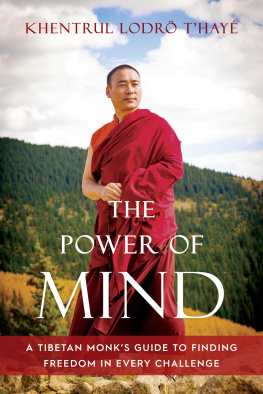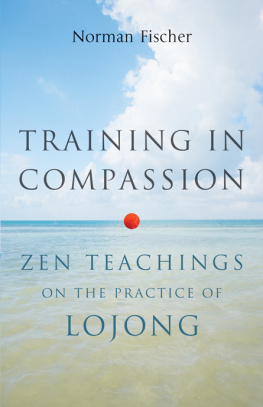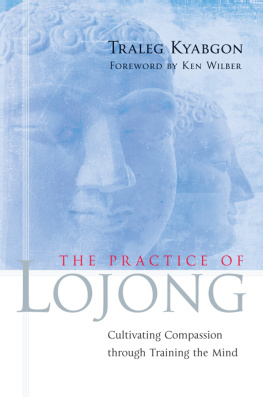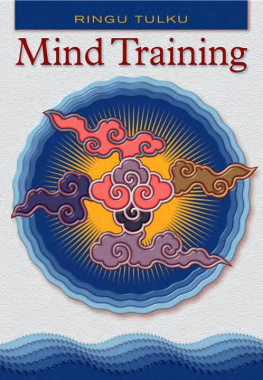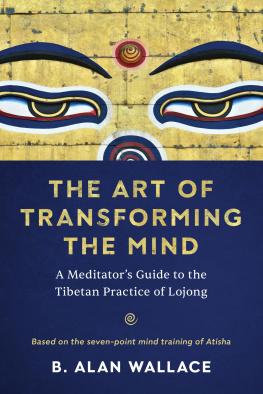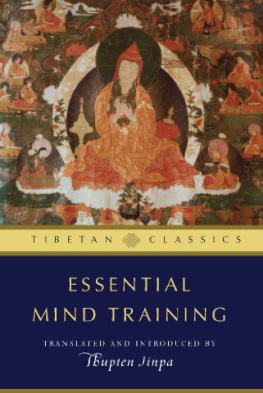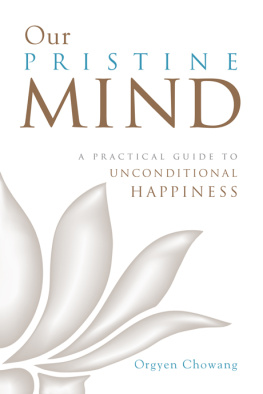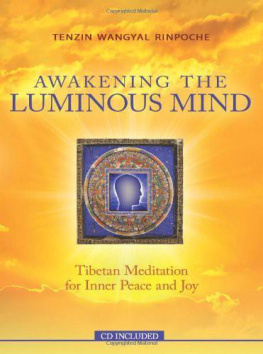Just as the saying goes, It takes a village to raise a child, so too it takes a community of editors and readers to capture Rinpoches oral teachings and share them with the world through the written word. We are grateful to all of Rinpoches students who contributed to this fruition in various ways. Thank you especially to Paul Gustafson, whose vision galvanized a core group of Katog Vajra Lings sangha in Connecticut to come together and participate in transcribing Rinpoches teachings, and then who spent more than six years organizing, editing, and compiling the original draft with me. Thanks to everyone who transcribed thisKathleen Hayes, Mike Larini, Roxy Pickering, Susan Shellard, Kris Yaggi, Karen Kernan, Laura West, and Paul Gustafson. Scott and Carly Caspers early support gave the project the jump start it needed. Cynthia Shumway provided feedback on the first draft and got us started on the endnotes and glossary. Lavinia Spalding provided kind and professional guidance on the introduction and biography. Ibby Caputo, our final editor, helped transform the first draft into a completed book with patience for both me and our vast learning curve. This was no small endeavor! Shamelle Gonzalez provided additional advice and insights, Shelley Jackson reviewed and helped polish the final draft, and Cyndi and Travis Wong helped us with some finishing touches. Jacqui Merrell copyedited the book, Kim Corrette and Susan Galligan contributed to last-minute edits, and Wyk Parish provided technical support. And special thanks to our agent Stephanie Tade who was so inspired by Rinpoches vision that she accepted him as a client and shepherded this book to its best home in Shambhala. Our appreciation for the team of competent and inspired staff at Shambhala has no bounds. They gave this book far more time and attention than we expected in the process of making it a realityso a huge thanks to acquiring editor Sarah Stanton, associate editor Audra Figgins, production manager Lora Zorian, interior designer Greta D. Sibley, marketer Johnnie Dina, publicist Michael Henton, copy editor Cannon Labrie, proofreader Emily Wichland, and indexer L. S. Summer. So many, many thanks to you all for helping bring Rinpoches teachings to a wider audience. And finally, to the humble yet magnificent monk at the center of all thank-yous, who inspired all of our efforts and who gave us this teaching, Khentrul Lodr Thay, may we repay your kindness by putting these instructions into practice ourselves and by sharing the opportunity to do so with others. All the merit accumulated through this process, we dedicate to taming the mind. May all beings be happy and may all beings be free.
APPENDIX 1
ATISHAS LIFE STORY AND THE LINEAGE OF MIND TRAINING
Jowo Je Palden Atisha was born in eastern India in a Buddhist kingdom known as Zahor in the Western calendar year 982. His father was a king and his family was very rich and influential. Many families depended on them. In that region and at that time in history, there were a lot of realized masters in India. It was common for such wise men or women to go and examine a child just after birth to see if the child had the special marks or signs of a realized being. Many such masters came to see Atisha after his birth and they all gave a similar prophecy. They said he was a very special child. If he became a king, he would be a great ruler, but if he entered the path of dharma, he would become a realized saint who would propagate the Buddhas teachings across the world and benefit numberless beings.
At a young age Atisha went to the great Buddhist university Nalanda in the ancient kingdom of Magadha in modern-day Bihar. There he studied and practiced under many qualified spiritual teachers. Later he continued his studies and served as an abbot in Vikramashila, another prominent Buddhist university also in Bihar. Through his training he became renowned as a pandita, a distinguished scholar of Buddhist philosophy, and a realized being. He was respected from the east to the west in India as one of the most learned scholars in the entire path of sutra and tantra. Thus was his scope of knowledge.
Yet Atisha was not satisfied with this study alone. He had heard of teachings called lojong, which combine all of the key points of relative and ultimate bodhichitta into an extraordinary style of instructions based on direct experiential application. The most well-known teacher of this approach was the master Jowo Serlingpa.
Jowo Serlingpa lived in what is now present-day Indonesia. It is far from Indiaacross the ocean. It was not an easy or safe passage at that time, but this did not deter Atisha. He was determined to seek out Serlingpa and receive his special instructions. Atisha embarked on a ship with a hundred other practitioners in pursuit of the teachings. Livestock and many other provisions were also loaded onto the boat. The journey took almost a year. During that time there were multiple storms, and they nearly lost the ship and their lives on several occasions. But the natural elements were not the only danger they encountered; there were many nonhuman beingsspirits and formless beingswho tried to thwart their journey to prevent them from receiving such profound dharma.
Even though Atisha had never met Jowo Serlingpa, he had great faith in him and prayed to him to dispel the dangers that arose. He also saved twenty-one women aboard the ship who almost fell into the sea. Later it was said that those women were emanations of the deity Tara, who were accompanying Atisha. Due to the power of Atishas personal deity practice, the presence of Tara, and his prayers to Jowo Serlingpa, he was able to surmount all of the obstacles and dangers and reach his destination.
Once in Indonesia, Atisha set out in search of Jowo Serlingpa. Everywhere he went he asked if anyone knew Serlingpa or where he might reside. After a few months of searching, a messenger reached Serlingpa and told him that an Indian pandita named Atisha had come to meet him. Serlingpa was delighted and together with a retinue of a hundred students went to greet Atisha.
Atisha supplicated him, saying, I heard you have a very special teaching on mind training. I have come to receive and practice those instructions. At the same time, he made a great mandala offering to the master and said, I will stay as long as it takes.
Serlingpa was very happy and invited Atisha back to his home. Atisha stayed there and served Serlingpa for twelve years, receiving all of the instructions and practicing diligently. They stayed in one room the entire time and even shared a pillow. And so they were together day and night as Atisha trained. The teachings were given in what is called the ripening instruction approach for taming self-clinging, whereby Serlingpa imparted one piece of advice at a time so that Atisha could fully practice and realize each point as he received it. In this way, Atisha received all of the instructions on relative and ultimate bodhichitta in the most profound and extensive manner. Finally, he became a master in taming his mind through the mind-training approach, equal to his teacher, Jowo Serlingpa. It was then that Atisha returned to India.
Once in India, Atisha taught mind training extensively to the ordained practitioners and laypeople before he decided to leave for Tibet in the Western calendar year 1039. He entered Tibet through the region of T Ngari. On the road he met with a Buddhist scholar and translator who asked him many questions about Buddhist philosophy. Atisha said to him, Perhaps there is no need for me to come to Tibet since there are learned scholars like yourself, but I have one last question for you. When you practice, how do you do it? The translator replied, You practice however it is explained in each text. With that Atisha exclaimed, Rotten translator! Perhaps there is a need for me here after all! Atisha knew that when we practice, we have to know how to synthesize the key points of all the teachings into a single practice.

